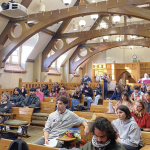Allie Mikalatos ’25
Copy Editor
Last semester, I was one of 11 students who were formally admonished by the Trinity administration due to our participation in a peaceful protest. In a Jan. 16 email to the campus community, Vice-President for Student Success and Enrollment Management Joe DiChristina removed our admonitions, stating that “the students involved understand why the admonitions were issued and are learning through the process.” He’s absolutely right. I did learn from the admonitions — but not the lessons the administration seems to think I did.
The first lesson I learned is that the administration does not follow its own rules. At Trinity, we are all bound by the Student Handbook’s policies about disciplinary procedures. But in my case, the administration did not consistently follow Student Handbook policies, making my disciplinary process difficult and painful to navigate. In addition, since Trinity’s standard in determining whether a violation of the Student Handbook occurred is a “more likely than not” basis, the Office of Student and Community Life doesn’t need to rely on facts or reality — they just need to think it is “likely,” in their opinion, that a violation has occurred. It was clear that the deans had made the decision to admonish me and other students as a warning to the student body, no matter what they found via the disciplinary process. In researching the protests of Trinity’s past, I realized that the administrators were using the same manipulative techniques which Trinity has been employing for decades.
In 1968, the Trinity Association of Negroes organized the student body to perform a sit-in at the Trustees’ April 22 meeting. Weeks prior, the Student Senate had contacted the Trustees with a request to discuss the development of a scholarship fund for Black students. The Trustees declined to respond. In order to convince the Trustees to engage in a conversation, over 250 students sat in Downes-Memorial for almost 36 hours. The sit-in concluded when the Trustees agreed to negotiate with the student body. By April 24, the Trustees enacted a new policy: Trinity would ensure full financial aid to at least 15 Black students each year from then on.
Soon after, Albert Jacobs, the president of the college, initiated charges against six of the 250 student protestors. Roy Heath, the dean of students, commented that the six students had been chosen “for obvious reasons” — they were allegedly leaders of the movement. The student body felt that punishing just 2% of peaceful protestors for the action of a collective was unjust. In response, 155 students signed a petition indicating they “desired to share the burden of any punishments levied by the judicial bodies of the College.”
President Jacobs said the charges, now levied against 162 students, would be handled “through regular College procedures.” In compliance with these procedures, on May 17, a joint student-faculty committee released a report finding all who were tried in disciplinary proceedings as guilty. The punishment, the committee wrote in the report, was engagement in “social work or a tutoring project.” But on May 18, the Trustees stepped in, violating the stated Student Handbook rules of the time that student-faculty committee decisions would be final. The Trustees instructed the registrar to place a disciplinary probation marking on student transcripts.
Following the Trustees’ violation of stated College policies, students and faculty banded together to seek justice. On May 19, 1968, after speaking with affected students, the faculty passed a resolution demanding the Trustees “withdraw the Probation” and collaborate with faculty and students in a review of the College’s judiciary process. Although the Trustees initially ignored the faculty resolution, the faculty persisted. In the first week of June, the faculty asked the registrar to add a special marking to the transcripts of the 162 sanctioned students: “This notation not approved by faculty.”
In overruling the student-faculty committee’s decision, the Trustees attempted to exert a chilling effect on on-campus freedom of speech — but the campus community united to insist that the right to protest is deeply important to any institution which claims to “prepare students to be bold, independent thinkers who lead transformative lives.”
This brings me to the second lesson I learned by engaging in Trinity’s disciplinary process: Our community — in the present and in 1968 — will not stand for the administration’s attempts to limit freedom of speech and intimidate student protestors. From professors who attended every meeting with me, to students, parents and alumni who emailed the administration demanding the admonitions be dropped, to the petition which 130 faculty signed that insisted the administration must allow peaceful protest on campus and rescind the admonitions, I made it through last semester because the Trinity community showed me and the other admonished students so much care.
And now, as of Jan. 21, my admonition has been removed. This removal did not come about from any kind of engagement with the College’s judiciary process. Rather, it is the result of continued pressure from the Trinity community. I have learned that in the face of injustice, the most powerful tool is organizing your community to speak up — and that the Trinity community, both past and present, refuses to be silent.


+ There are no comments
Add yours